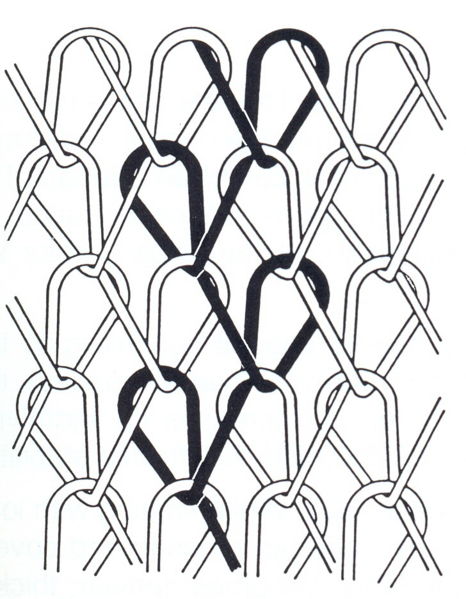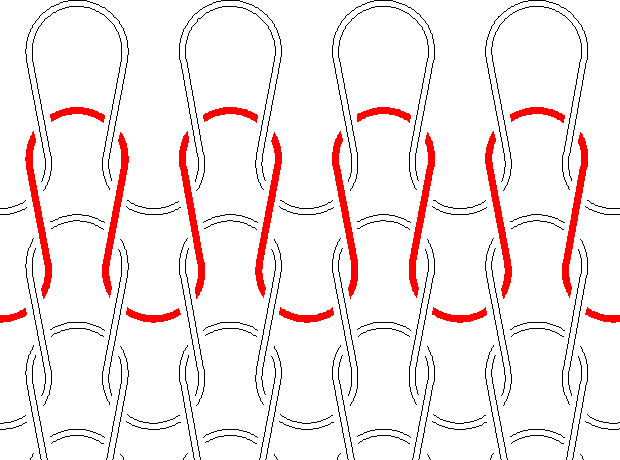---
Band -- A strip of fabric that extends and finishes an edge of a garment makes a banded edge. The band is often a rib or very stretchy jersey fabric, and is usually used at the neck, sleeve, or bottom edges of sweaters.
 |
| Rib band on a sweater knit fabric |
 |
| Jersey binding on a sweater knit fabric |
 |
| A single course is between the grey lines. |
Cut and sew knitwear -- Knitwear that is constructed much the way woven garments are made. The garment pieces are cut out of already knitted fabric. The pieces are then sewn together to create the garment. It's a technique that's often used industrially and is also accessible to anyone with a sewing machine.
Double knit -- A very stable, balanced rib fabric that looks like two jersey fabrics glued together, though it's not constructed that way at all. The double knits of the 70s gave the category a bad rep, because they were made of polyester, but there are many gorgeous double knits being produced today. The example below is 100% merino wool.
 |
| This may look like a jersey, but the reverse looks exactly the same; it's a double knit 1x1 rib fabric. If you were to give it a good stretch sideways, you'd see the ribs. |
Facing -- A facing is a partial lining which finishes the raw edge of a garment. It will often add stability to a knit fabric, especially if the facing is interfaced or if a woven fabric is used. Like the facing used in dressmaking, it follows the shape of the garment. It's sewn to the garment right sides together, then turned to the inside of the garment.
Fully fashioned knitwear -- Each piece of the garment is shaped as it's knitted and then sewn together to create the garment. Increases, decreases and short rows are the methods most often used to shape the pieces. Hand knitters and those who use hand knitting machines often work this way. Many industrial machines can be programmed to use this method to shape the pieces of a garment.
Intarsia -- A type of jersey fabric with two of more colors in a horizontal row of stitches but no floats carried on the back of the fabric.
Interlock knit -- A very stable, relatively heavy knit, that may look like the front side of jersey on each side of this fabric. When stretched, it does not divide into ribs the way a double knit rib fabric does. Interlock knits have a smooth surface. They are easy to cut and sew because the edges do not roll. These fabrics are often used for prints, because the surface is smooth. (Read more about interlock.)
 |
| There is no way to know that this is an interlock knit just by looking at this picture! |
Jersey fabric -- One face of the fabric has knit stitches (V-shaped stitches) and no purl stitches. The other face has purl stitches and no knit stitches. (A purl stitch is simply the back side of a knit stitch.) The edges cut across the stitches roll toward the knit side. The selvages (and edges cut parallel to selvages) roll toward the purl side.
Knit -- The knit stitch is the interlooping of yarn or thread through an existing loop of yarn or thread. Making many of these loops in a grid structure creates the knit fabric. (See picture of jersey fabric above.See also warp knit fabrics and weft knit fabrics below.)
Knit&wear -- A method of manufacturing knitted garments with few seams on specially designed, advanced industrial knitting machines by Stoll. (See Seamless Knitting and Whole Garment Knitting.)
Openwork -- Term used to describe a structure of fabric where holes or openings are used as a design element. Besides knits, openwork fabric can be crochet, woven, or non-woven.
 |
| A knitted openwork fabric |
Purl -- A purl stitch is the back side of a knit stitch. A purl fabric is a weft knit fabric where both knit stitches and purl stitches appear in the same wale (column of stitches). Purl fabrics can have very complex textures. (Read more about purl fabrics.)
Recovery -- The ability of a knit fabric to return to its original size after being stretched. This quality is usually determined by fiber and/or stitch size. A fabric which readily returns to its original size after stretching is said to have good recovery.
Rib fabrics -- Each wale (column of stitches) has either knit stitches and no purl stitches, or it has purl stitches and no knit stitches. Sweater cuffs are often, but not always, rib fabrics. Double knits also fit into this category, though it may be hard to see the actual ribs unless you stretch the fabric. Balanced rib fabrics do not roll at the edges.
 |
| A 3 x 2 rib fabric |
Seamless Knitting -- A way of manufacturing knitted garments with few seams on specially designed, advanced industrial knitting machines by Santoni. (See Seamless Knit&wear and Whole Garment Knitting.).)
Wale -- A vertical column of stitches that is parallel to the selvage (when knitted on a flat knitting machine).
 |
| A single wale in this fabric has both black and white stitches. |
Warp knit fabrics are made on machines with the yarn travelling primarily in a vertical direction. Tricot is one example of a warp knit fabric.
 |
| Example of a warp knit fabric (Credit: Wikimedia Commons) |
Weft knit fabrics are made on machines where the yarn follows primarily a horizontal path.
 |
| Example of a weft knit fabric (Credit: Wikimedia Commons), the red yarn indicates on "course" of the fabric. |
Whole Garment Knitting (Also "Seamless Knitting" and "Knit&wear") -- A way of manufacturing knitted garments on specially designed, advanced industrial knitting machines by Shima Seiki, Santoni, and Stoll, respectively. The garment is created in one piece without seams with this method. Hand knitters who create garments totally on circular needles do a hand crafted version of this.
---
Suggestions are welcome!
To be continued...
O!



Your post is good
ReplyDeleteThank you, Ricky.
Deleteargyle, intarsia, cast-on, cast-off, linking, plaited... ;) good words to include in your awesome glossary. Thanks for compiling this!
ReplyDeleteAll great candidates, Hada! I'm not sure I'll include cast-on, cast-off, and linking, since they're terms a sewist may not come across, but the others will be added. I appreciate your suggestions!
Delete